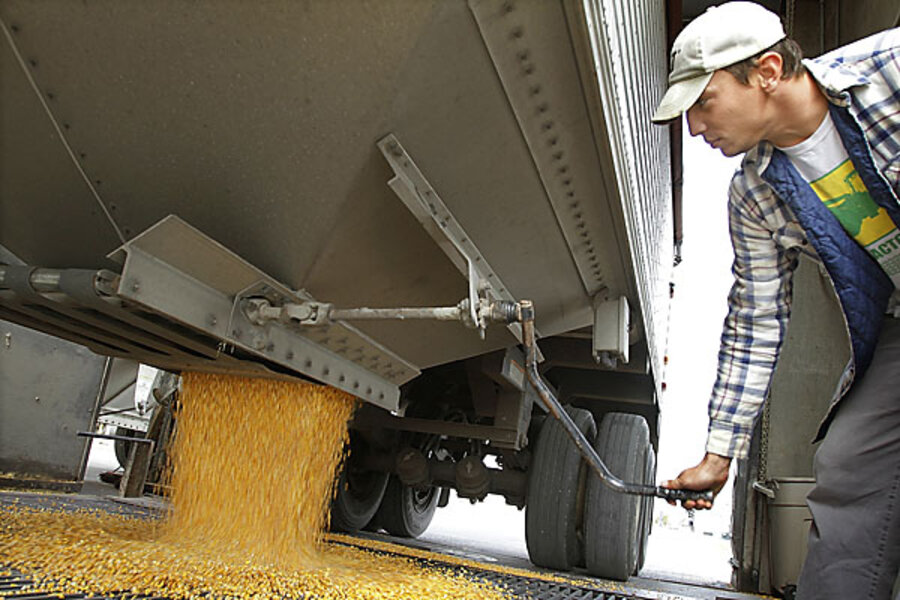How ethanol production could make for crumbly corn chips
Loading...
We want corn for at least two reasons. We want junk food and we want corn based ethanol. This article highlights a tension inherent in a recent ruling by the USDA that allows for a new corn to be grown for commercial use. "The corn, developed by Syngenta, contains a microbial gene that causes it to produce an enzyme that breaks down corn starch into sugar, the first step toward making ethanol. Ethanol manufacturers now buy this enzyme, called alpha amylase, in liquid form and add it to the corn at the start of their production process."
SO, the ethanol manufacturers will enjoy a cost savings because they will need to buy less alpha amylase because the corn will "break itself down" to begin the process of transforming it into ethanol.
There is a potential problem though. "The decision, announced Friday, came in the face of objections from corn millers and others in the food industry, who warned that if the industrial corn cross-pollinated with or were mixed with corn used for food, it could lead to crumbly corn chips, soggy cereal, loaves of bread with soupy centers and corn dogs with inadequate coatings."
I do not have an opinion here on what is the right public policy but I'm always interested in how we resolve externalities. I am not an agricultural economist but this case raises a classic spatial externality issue. We have competing uses for scarce land and one use of the land (growing the corn ethanol) creates risk for nearby parcels of land that continue to grow corn for food. So, this sounds like we need a MOAT.
We need firewalls between these two types of corn to make sure that my frito chips do not become soggy or crumbly. I would like to ask a scientist here --- how would these corn fields "co-mingle"? Would wind patterns do it? Or birds eating in one place and pooping in another? Would a physical separation of these corn fields be sufficient to minimize the probability of this "contamination" of the food corn? "The association said that Syngenta’s own data indicated that as little as one amylase corn kernel mixed with 10,000 conventional kernels could be enough to weaken the corn starch and disrupt food processing operations."
What investments can be made upfront to minimize the probability of this bad scenario? How do we minimize the probability of cross-pollination? The creation of a spatial moat between these two types of corn offers one potential solution. Armed with GIS maps of which corn is grown where --- this would help to reduce the probability of crossed corn. (THIS post has been updated).
this article sketches that this same issue appears over and over again in agriculture and that in some cases that farmers have figured out ways to reduce the risk.
"The Willamette Valley Specialty Seed Association uses a simple system to avoid cross-pollination: A map of the valley with pins in it shows where each type of crop is planted. It’s first come, first served — if you “pin” a sugar beet field, nobody else is supposed to grow seed for Swiss chard within three miles.
“Apparently they aren’t finding any of my red chard or golden chard seed in their sugar beets, and I’m not finding any of their genetics in mine. That I know of,” Morton says. “There’s always some question, and that’s the problem — there’s always some question.”
The Willamette Valley Specialty Seed Association has a system for avoiding cross-pollination, and the approach is charmingly low-tech: just a map of the valley with a lot of pins stuck in it to show where each seed crop is planted. For farmers, it’s first come, first served — if you “pin” a sugar beet field, nobody else is supposed to grow seed for Swiss chard within three miles."
In this case, how was this equilibrium enforced? Did local social norms enforce it? (see Nobel Laureate Ostrom's's work). UPDATE: Now there is nothing "magical" about three miles as a separation boundary. In fact, my mother just sent me this email: " I think you'd better do some more factual research on dispersal beyond three miles of genetically modified seeds. Birds travel thousands of miles and are traditional seed dispersers. I think farmers have been yelling about bird dispersal for years thus an intellectual theory of a three mile limit doesn't conform to fact. You don't want to undermine your credibility on a theoretically logical theory that doesn't square with fact."
As usual, my mother is right but the intellectual point remains. We have ways to reduce the spatial externality between land uses. Information technology can be used to create "firewalls" here. I could imagine that detailed maps could be made to identify the physical border of where plots of corn land devoted to ethanol are close to plots of land where corn is used for Fritos. It is these border areas where the risk of cross-pollination would be the highest. Extra care must be invested here to minimize the probability of spillover damage.
This is a classic Coase theorem question in a "Brave New World". The lawyers will have to determine who has property rights in this case.
Add/view comments on this post.
------------------------------
The Christian Science Monitor has assembled a diverse group of the best economy-related bloggers out there. Our guest bloggers are not employed or directed by the Monitor and the views expressed are the bloggers' own, as is responsibility for the content of their blogs. To contact us about a blogger, click here. To add or view a comment on a guest blog, please go to the blogger's own site by clicking on the link above.





